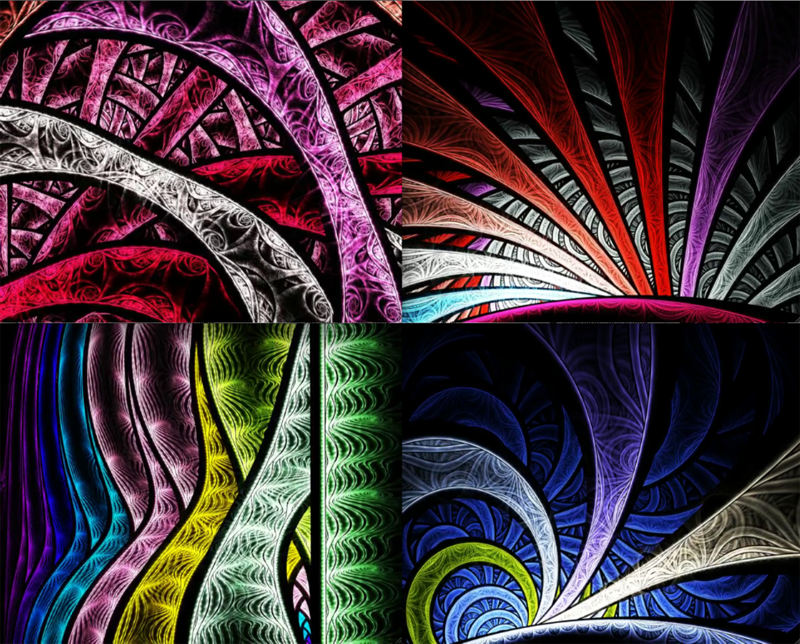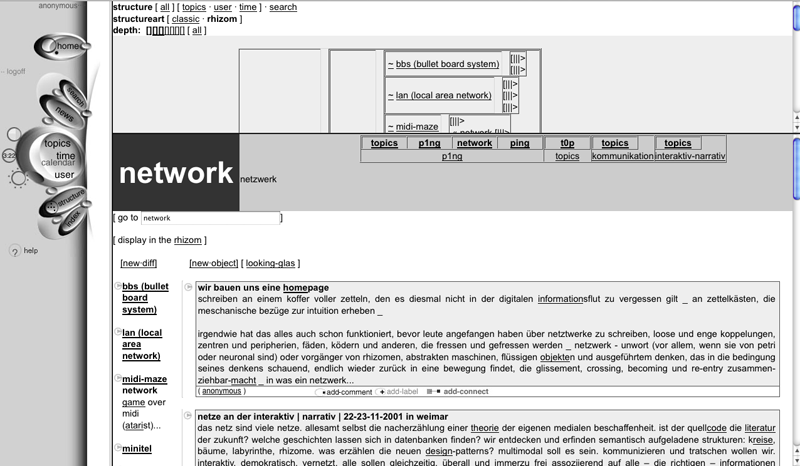IASLonline NetArt: Theory
Thomas Dreher
History of Computer Art
VIII. Summary
VIII.1 Three Modes
In what follows three modes are presented as characteristics of procedures used in computer art: Relations between the humans at interfaces, programming and computing processes are shaped by generative, hypertextual and modular procedures.
In Evolutionary Art (see chap IV.3.1, IV.3.2) the selections in the course of a basically infinite computing process are executed either as parts of the programmed selections between possibilities, or, alternatively, by the observers when they take over the selection in the manner provided by the program. 1

Draves, Scott: Electric
Sheep, computer network, internet, screensaver, 1999.
Screenshots of phases following one after another (November 2012).
The programs consist of systems determining the generative procedures. In Evolutionary Art the results of preceding processes are transformed in the course of the computing and alternatives are offered to the following generating phases. The output media present these processes in the time dimension (time-based media) and offer observers interfaces to select alternatives. Despite these chances for selections by observers the programmed computing process remains the leading "agent": The observer is enabled only to select one of the alternatives preconditioned by the programmed generative procedure. In cases when observers don´t intervene the system selects one of these alternatives. If an observer takes the role of an "agent" then he does not interrupt the computing process but becomes an initiator co-determining the following generations. Observers monitor the largest portion of the generating process as "patients" (as passive observers of the computing process). 2
Evolutionary Art is a variant of Generative Art. The term `generative´ designates transformative procedures without determined end: The process of the transformations of the transformed is the path and the goal.
In the structures of databases for hypertexts observer operations (see chap. V.1 with ann.1) are integrated as the actions of cooperating participants (see chap. VI.2.3) deciding on the selection of texts. Their division of texts in sections are saved on cards or "nodes". These parts are designated by "labels" or "topics" and connected by links. 3 These processes are stored on servers. On terminals the stored parts can be recalled and participants can add new parts. The participants are "agents", and the database is the collective memory of the participants. The machine memory of a hypertext database is "patient" until the database-external "agents" activate it to open stored data and to store new inputs. A machine memory with digital writing systems initiates, modificates and augments the participants´ cognitive capabilities: "Augmenting Human Intellect". 4
Bauer, René/Maier, Joachim: nic-las, Stalker, since 1999, web project.
In the hypertextual procedure the roles of "agent" and "patient" are distributed contrary to the generative procedures: The main actor of hypertextual procedures is the observer connecting himself with other participants. Compared to elder writing systems and established uses of language the participants of hypertext systems use their language competence and the database in a modified communication system. For the participants their coordinations of signs with meanings continue to be a fundamental factor during all their actions on terminals. In contrary to the hypertextual systems, in generative projects the computing processes intitialised by codes cause the output media to confront observers with a machine independently producing changing formations. Toward this generating "agent" and its output observers behave "patient": They try to reconstruct the scale of the output possibilities meanwhile they follow several phases of the generation process.
Meanwhile in hypertextual systems codes are used to connect stored text characters with regard to semantic fields established by the everyday language use, generative procedures are constituted by a computing process being controlled by a program: The programming code contains either no signs being precoded in computer-external contexts, or it uses code elements either to integrate precoded signs into the generation process as moving signs or to transform the signs´ outlines with desemantising effects.
In hypertextual systems the "algorithmic signs" 5 are used in links, anchors, etc. and integrated in texts as a means of the coordination of semantic fields, meanwhile the "algorithmic signs" are fundamental in programs initialising generative computing processes controlling output media. Observers can investigate the time-based output of generative projects concerning the relations between the program and its realisations: The recursion to the technical configurations is a plausible observing operation (see chap. V.1 with ann.1) to be able to follow the ouput of generative procedures, meanwhile hypertextually organised databases sustain the semantics and the participant´s memory function. The results of computing processes initialised by generative programs are not made to fulfill always the observers´ expectations. The output either provokes indifferent and wait-and-see observing operations, or it causes disturbing and investigating familiar perception patterns challenging the observers´ cognitive capabilities, meanwhile the hypertexts simplify and augment the uses of "semantic webs" 6 integrating precoded semantic fields as they were established in elder communication media.
Today three-dimensional simulations can be developed on personal computers with animation programs. The programs include elements as modules like the ones presented in the chapters IV.2.1.2 and IV.2.1.3. Designers construct 3D objects in using these program modules. Then for these objects points of views are selected for inclusions in film sequences. 7 In the development of a film animation designers choose and test different states of an object meanwhile they follow artistic criteria and the storyboard´s notations: Its hand-made sketches (see chap. IV.3.1) present the specifications for the planned image sequences. In realising the sequences of a storyboard designers mediate the modular possibilities of an animation program with the patterns used in human perception to recognise objects and movements.
In the eighties an animation designer chose the perspective and sizes of a three-dimensional object processed with programs for frame models, polygon surfaces and with methods to smooth the polygons as well as for surface qualities like texture, colour, light reflections and shading. Since the midst of the nineties animation programs for personal computers integrate these procedures together with further image editing procedures in one system. Since then the designers of film animations use frequently two-dimensional image templates as basic elements. Designers can variate the selection possibilities of an animation program´ s modules in their efforts to follow cinematographic and aesthetic criteria in the process to find the best variants as realisations of storyboards. When a designer jumps back and forth between the visual perception of provisional results and an adjusting control of the program´s modules then also the roles of "agents" and "patients" change between the designer and the computer. This change is typical for working processes with "modular" procedures on which Lev Manovich focused his investigation of "Info-Aesthetics". 8
For the animations of computer games designers include processed 3D elements in the game engine´s databases and program possible courses of gameplays by following the criteria of immersion (see chap. VII.1.3 with ann.76). Meanwhile the spectators of films with computer animations view the results of a modular organized production in the position of "patients" only, players of computer games explore the 3D worlds and `meet´ the simulated bodies and objects from several sides and points of view (see chap. VI.1.3.1): The modular procedure is a precondition for the playing "agent" enabling him to view objects in different angles and to experience some of these objects as ennemies (f.e. EverQuest, Massively Multiplayer Online Role-Playing Game by Verant Interactive, 1999).
Verant Interactive: EverQuest, 1999, MMORPG.
In modular procedures the software supports possibilities to develop virtual worlds step by step and from decision to decision by following artistic criteria, meanwhile in Generative Art artistic criteria can only be a part of decision-making processes in programming, and – beside some possibilities for selections by observers – are excluded when the programmed algorithms are unfolded by computing processes. However in hypertextual procedures the links are placed by interventions in texts: For links and anchors the codes controlling connections and concatenations are inserted by participants between (parts of) texts adhering to semantic criteria. In hypertexts the effects of functional elements are decisive on a semantic level, meanwhile in Generative Art the focus of the observer´s attention is directed to the relations between the code and the presentations of output media being generated in computing processes. Hypertextual procedures are activated by human interventions into text structures: Hypertexts don´t surprise observers by an unfolding of computing processes without human interventions, in contrary to Generative Art and its predecessor, the permutational computer literature (see chap III.1.2, III.1.3, VI.2).

Agent-patient-relations for the three modes to use computing processes in Computer Art.
Dr. Thomas Dreher
Schwanthalerstr. 158
D-80339 Munich
Germany.
Homepage with numerous articles
on art history since the sixties, a. o. on Concept Art and Intermedia
Art.
Copyright © (as defined in Creative
Commons Attribution-NoDerivs-NonCommercial 1.0) by the author, December
2012 and June 2014 (German version)/ June 2014 (English version).
This work may be copied in noncommercial contexts if proper credit is
given to the author and IASL online.
For other permission, please contact IASL
online.
Do you want to send us your opinion or a tip? Then send us an e-mail.
Annotations
1 Cf. Sims, Karl: Generative Images, 1993, reactive installation, in: see chap. IV.3.2 with ann.22-25; Draves, Scott: Electric Sheep, 1999, computer network, internet, screensaver, in: see chap. IV.3.3. back
2 Seifert: Co-Evolution 2008, p.12: "Agent and patient are defined as relata of the action relation. In an action relation `x acts upon y´ the relatum x is called `the agent´ and y `the patient´, if x acts upon y...As exemplified by Mario Bunge´s definition of terms such as `action´ and `interaction´, the meanings of `action´ and `interaction´ encompass human and non-human actions." (Cf. Bunge: Science 1998, p.41,310,463s.) back
3 Labels ("Etiketten")/topics: Kuhlen: Hypertext
1991, p.87,89s.; Bolter: Space 2001, p.29.
Node: "A node is something through which other things pass, and which
is created by their passage." (Slatin: Hypertext 1991, p.162). back
4 Engelbart: Intellect 1962, see chap. VI.2.1. back
5 Dreher: Art 2005/2007, chap. V.2; Nake: Zeichen 2001. back
6 Trunk: Netze 2005, esp. p.19ss. back
7 Cf. Lev Manovich on "After Effects" (since 1993): Manovich: After Effects Part I & II 2006; Manovich: Software 2008, Part 2, Chapter 3, p.110-193. back
8 Manovich: Software 2008, Part 2, Chapter 4, p.212:
"...the animator sets the initial parameters, runs the model, adjusts
the parameters, and repeats this production loop until she is satisfied
with the result...the animator maintains significant control."
Info-Aesthetics: Manovich: Info-Aesthetics 2001.
Modularity: Manovich: Language 2001, p.30s.,136-141,289; Manovich: Software
2008, Part 3, Chapter 5, p.246-261. back
[ Table of Contents | Bibliography | Next Chapter ]
[ Top | Index NetArt | NetArt Theory | Home ]
